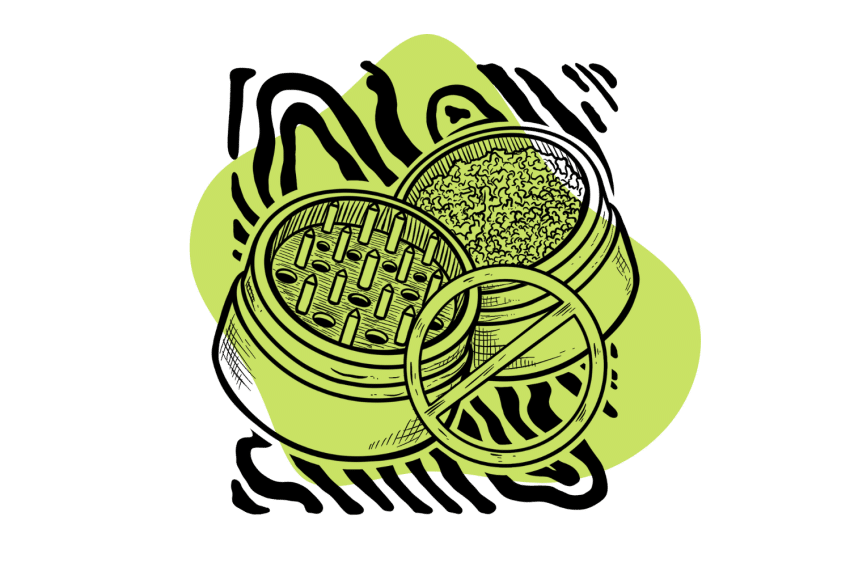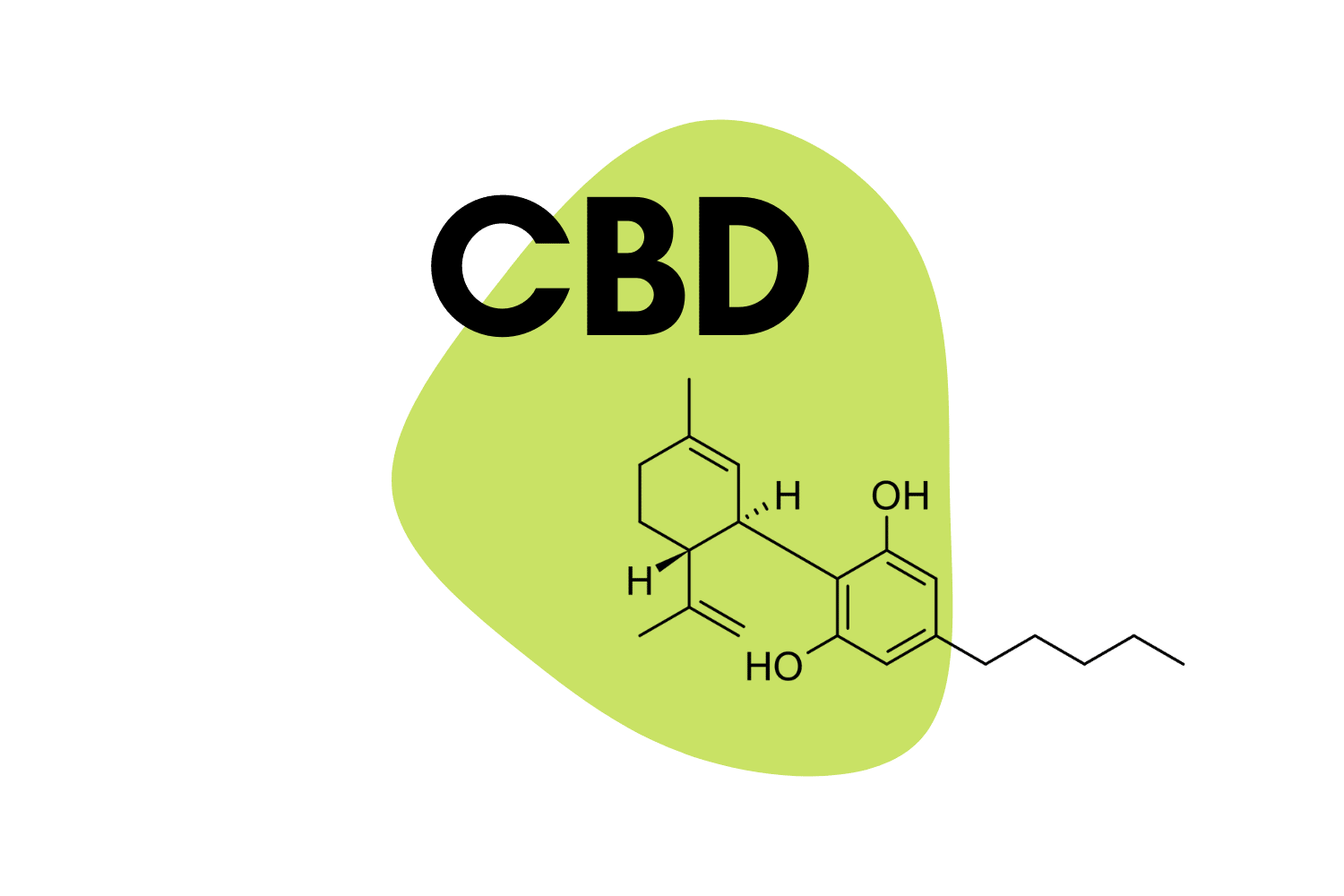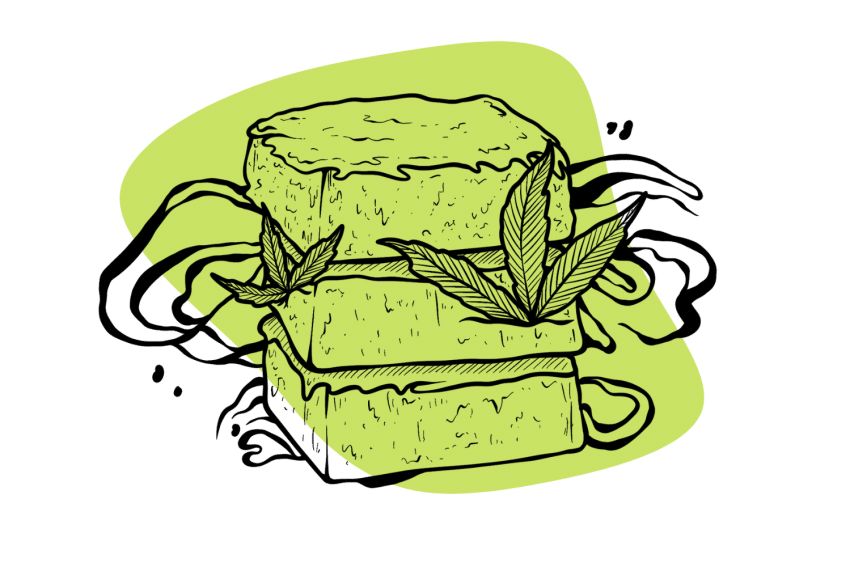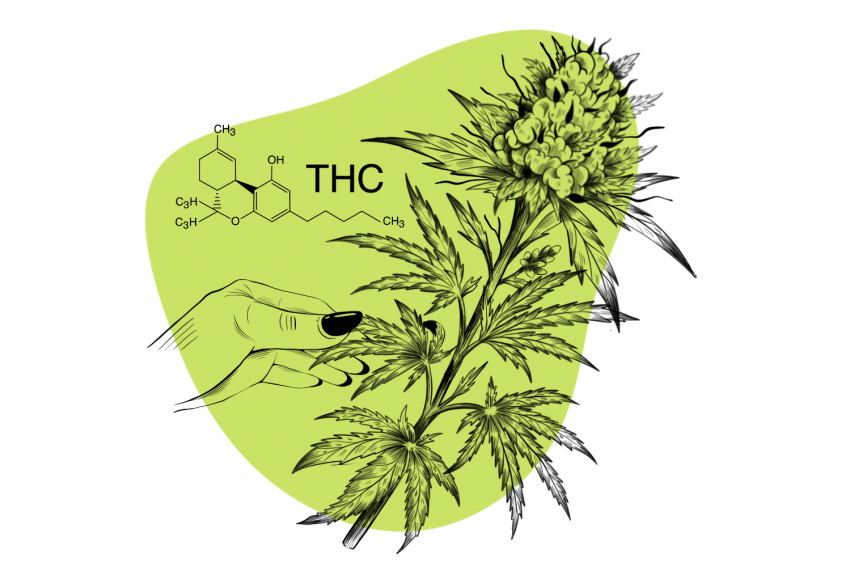The Art of Making Cannabutter (And What to Do With It)
There are only a few steps to making weed butter. Once created, ANY recipe that uses butter can be turned into a cannabis-infused delight.
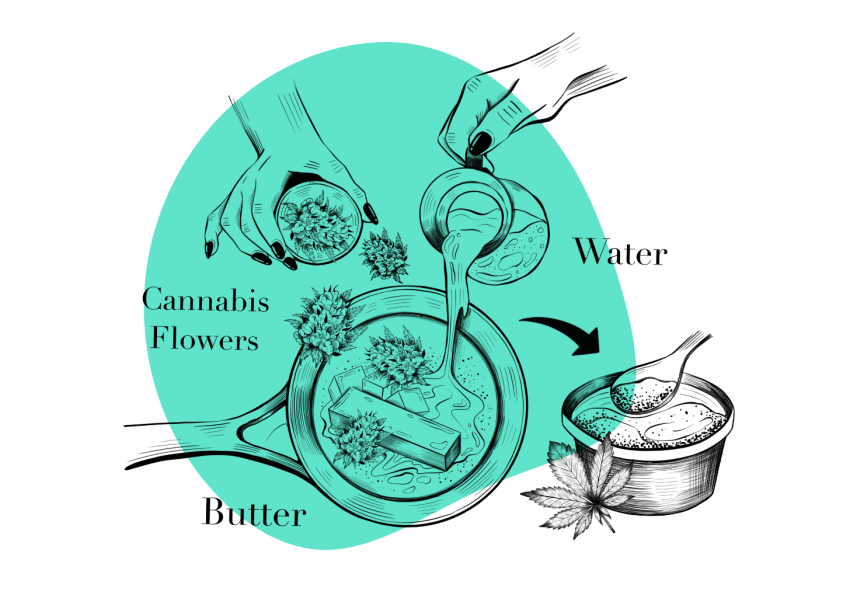
Cannabutter (weed butter) is the key to making just about any cannabis-infused dish. Any recipe that calls for butter or oil can become weed-infused. The possibilities are nearly endless!
While weed brownies are the most popular, this is far from the only thing you can make. Anything that uses fats like butter or coconut oil can be made into weed edibles.
The first step is to infuse your butter (or coconut oil) with weed.
We’ll explain the process in detail below, followed by a few simple recipes to create your own mind-blowing snacks.
Step-By-Step Guide to Making Cannabutter
Making weed butter is very simple — mix cannabis with butter and water in a pot, then simmer, strain, and separate, but we’ll break these steps down into more detail.
You can always replace butter with coconut oil if you prefer — but butter works best.
Step 1: Decarboxylation (Optional)
Decarboxylation is the process of activating your weed.
In its natural state, marijuana contains THCA, a non-intoxicating compound that turns into THC when heated. This conversion process is called decarboxylation, and it usually happens when you spark up a bowl or light up a joint [1].
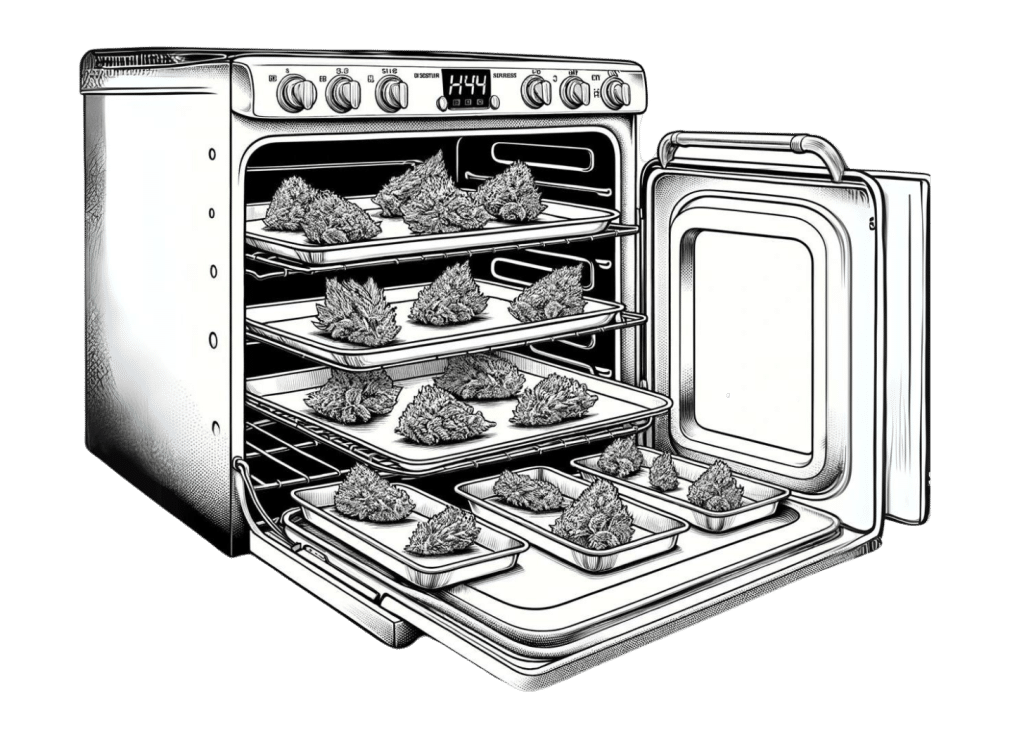
You might think this step is unnecessary since the weed will heat up with the butter later, but decarboxylating the cannabis ensures your end product is potent enough. It’s up to you if you want to decarboxylate prior to making your butter or allow the process to take care of it for you.
The benefit of decarboxylation is that it ensures maximum potency of the final product. The only downside is it can negatively affect the taste. So, if you’re optimizing for taste, leave the buds as-is — your butter will still be strong. If you want potency, decarboxylate your nugs first. We have an article that explains in detail how to decarb weed.
How to Decarboxylate Your Weed
- Preheat your oven to 245℉ (114℃)
- Spread the buds on a nonstick pan or a pan lined with parchment paper while the oven preheats.
- Bake for around 30 minutes; for even cooking, rotate the pan and move the buds around every 5 minutes.
- Remove the decarboxylated weed from the oven and let it cool down.
- Coarsely grind the buds once they’re cooled completely. Don’t grind them too fine unless you don’t mind them in the butter.
The key to this step is to bake them at a very low temperature to avoid burning. If you suspect your oven is too hot, use an oven thermometer to ensure it reaches the desired temperature.
If it doesn’t go that low, consider setting it to its lowest temperature and leaving the door slightly ajar to let the excess heat escape.
While you preheat your oven, grab an oven-safe nonstick pan or line a regular pan with a sheet of parchment paper. This will prevent the buds from sticking to the surface as they release some of their oils.
Spread your flowers evenly on the pan’s surface and put them into the preheated oven for no more than 40 minutes. Older, drier weed may only take 25 minutes to decarboxylate, while fresher buds will need more time.
Alternatively, you can bake the buds at 300 ℉, but they’ll be done sooner — around 15 minutes — so you’ll have to watch them closely, or you’ll risk losing some terpenes and cannabinoids.
Once your flowers are decarboxylated, grind them without going overboard. If ground too finely, they could make the straining process more difficult.
2. Mix Your Weed, Butter, & Water In a Pan
This is the most important part of the whole process and defines the quality of your end product.
Since THC binds to fats, you can use any cooking fat, such as butter or coconut oil. Avoid margarine or fat-free butter. Consider splurging on a higher-end butter or oil, but this is an optional step, so you can ignore it if you’re tight on money.
Begin by gathering the ground weed, butter, a cup of water, and a medium saucepan. How much weed you use is up to you, depending on how strong you want it — you can use anywhere from 7-14 grams, just make sure you measure it. Below, we’ll discuss how to figure out how much THC is in the final product.
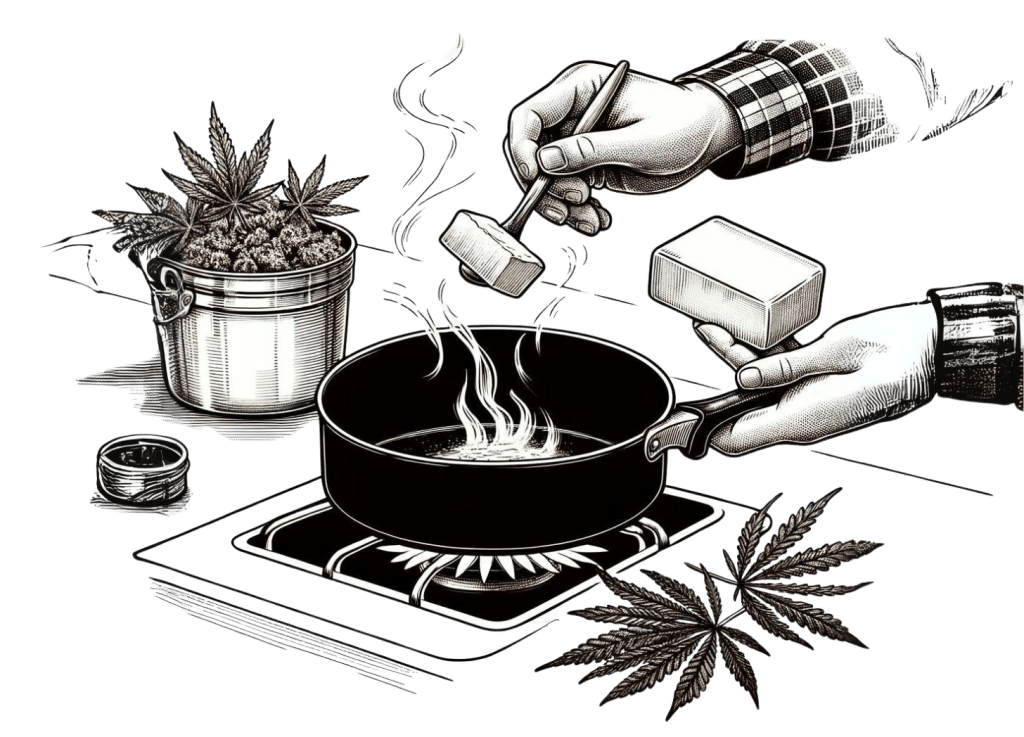
Combine the water and the butter in the saucepan and let it melt on very low heat, adding the cannabis once it’s completely melted.
There is some discrepancy on how long to simmer it for. Most often, you’ll hear it needs to simmer for at least 3 hours, but Food52 experimented and found that 80-90% of the cannabinoids were infused after 45-60 minutes.
The key to this step is maintaining a very low temperature, as it prevents the milk solids in the butter from burning. A candy thermometer can help you make sure the temperature doesn’t go over 190℉ (87℃).
A double-boiler can help you control the temperature better. To do this, simmer a small amount of water in a pot on low heat and place an appropriately sized bowl on top of it. You want it to sit in the pot but not touch the bottom, and you don’t want water to get into the bowl. Place your ingredients in the bowl and let them cook slowly.
The water evaporates over time, so keep an eye on it and refill it with hot water when necessary.
If you own a crock pot, just throw the weed, butter, and water into that, but it’ll take longer. Or go completely hands-off and use a pressure cooker if all these steps sound like too much fuss.
Infusion Summary:
- Melt one cup of butter with one cup of water in a saucepan over low heat.
- Once it melts, add your ground, decarboxylated cannabis to the mix.
- Let it simmer for 1-4 hours, stirring occasionally to prevent burning.
- If your stove is too hot, use the double boiler or crockpot method.
After the cooking time passes, remove the saucepan from the stove and quickly move on to the straining process.
3. Strain, Cool, & Separate
By the time your weed butter has finished infusing, you should already have your straining station ready.
Prepare it by setting a mesh strainer over a heatproof container. Lay cheesecloth in it to capture stray bits.
Pour the mixture over the strainer slowly to let it pass through the cloth. If you dump it suddenly, the plant material could clog the strainer, causing an overflow.
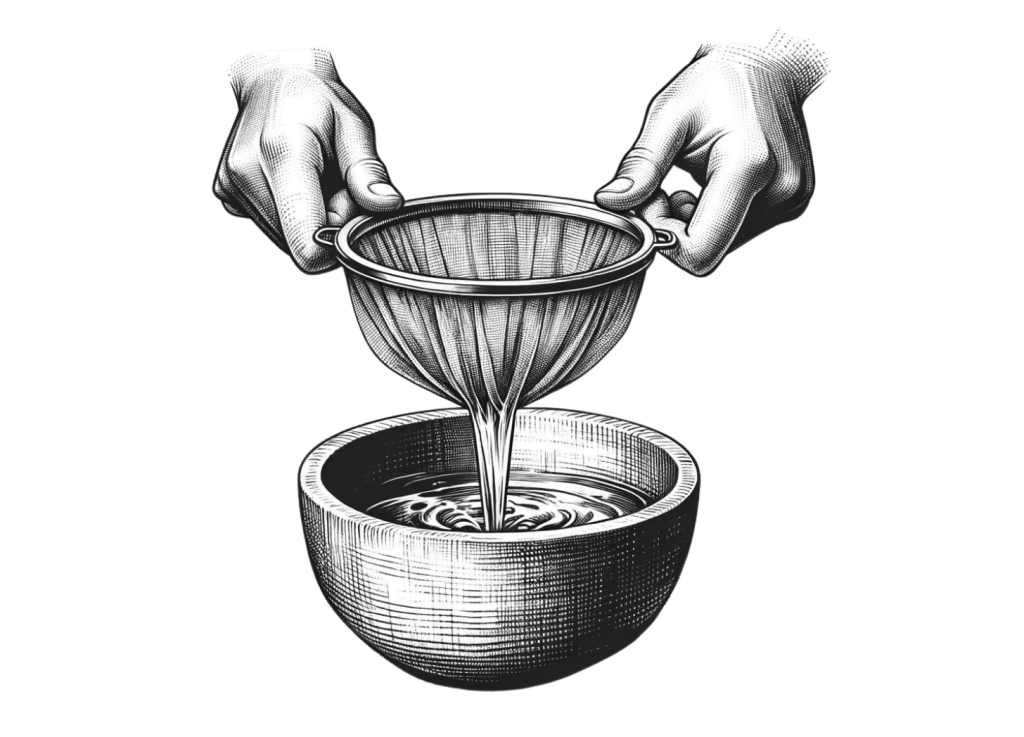
After you finish straining, gently squeeze the cheesecloth to extract the rest of the butter from it. Don’t squeeze too hard; you could extract the chlorophyll, giving your product a plant-like taste.
Allow the butter to reach room temperature, then refrigerate it so it can solidify. It will be watery, but the lipids separate as it cools, making it easy to remove the butter from the murky water.
Straining & Cooling Summary:
- Prepare your straining station by placing a mesh strainer and cheesecloth over a heatproof container.
- Pour the butter slowly so it doesn’t overflow.
- Let it cool completely.
- Separate the butter from the water.
4. Dry & Reconsolidate
Before you store your butter long-term, remove as much of the remaining water as possible to keep it from degrading.
Remove the floating slabs of butter from the water and place them on a paper towel for a few minutes to dry. Dab the surface to remove excess moisture.
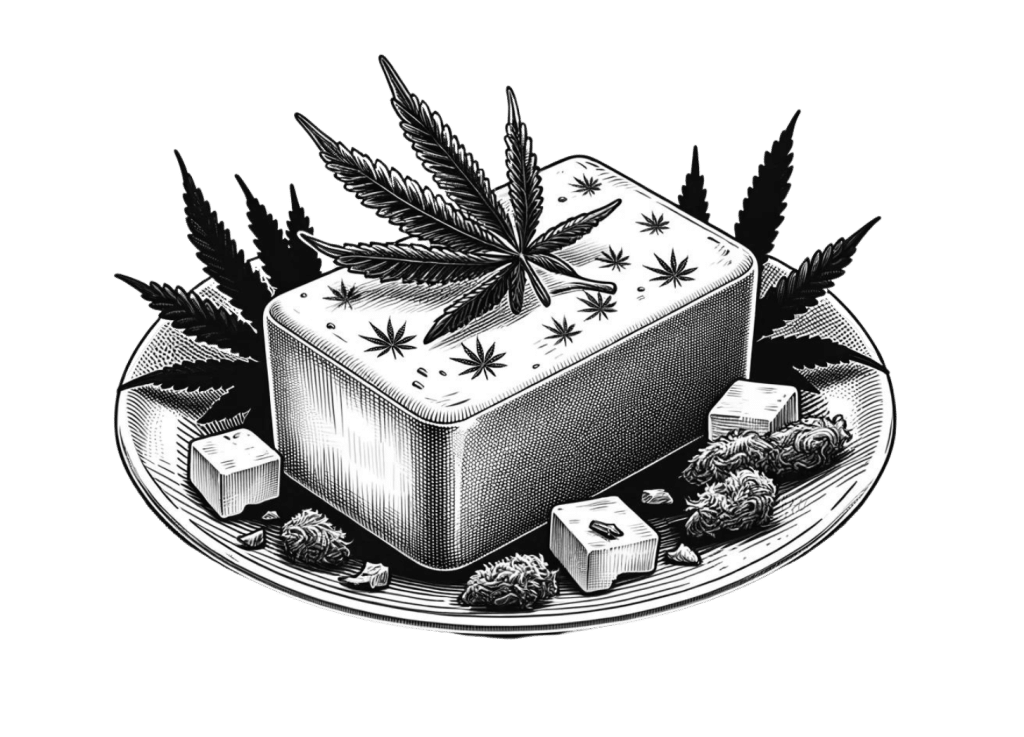
Next, combine your chunks of weed butter into a new container or a pan and gently heat in the microwave or over the stove to melt everything together. Avoid overheating — you’re only melting the pieces so they reconsolidate.
Your butter is now ready to use!
How to Store Your Cannabutter
Store your weed butter in an opaque container to shield it from light. Light is one of the cannabinoids’ worst enemies and makes them quickly degrade, which could impact its potency.
Your cannabutter should remain fresh for around three or four weeks, and you can freeze it for up to one year. Freezing it won’t significantly degrade its compounds.
How Much THC Per Serving? Figuring Out Dosage
Due to how varied weed potency can be, it’s difficult to establish a weed-to-butter ratio that consistently contains the same amount of THC. Even if you could standardize the potency of your weed butter, other factors would come into play.
It takes a little math to figure out the approximate amount of THC in the cannabutter and then more math to break it down per serving.
These numbers are helpful, but it’s a good idea to test the butter’s potency before adding it to recipes. Just measure 1/4th of a teaspoon of the cannabutter onto toast (or eat it plain) and see how you feel after 1 ½ hours.
Here’s the math for figuring out the approximate THC levels for the cannabutter:
(Grams of cannabis) * 1,000 * (Percentage of THCA in decimal form) * 0.88 * 0.7= Total THC
This takes into account the amount of THCA that could convert to THC during the decarbing process and how much is infused into the butter.
This will give you an idea of how much THC is in the butter so you can do more math and figure out how much is in each serving. For example, if you use ¼ cup of cannabutter in a recipe, divide the total THC by 4, and then divide that number by how many servings you have.
This isn’t 100% accurate, though, so start small. It’s better to assume there’s more THC in there than you think.
Tasty Cannabutter Recipes
Now that you have an idea of how much THC is in the cannabutter, you can make stuff with it.
Here are two easy recipes, one sweet and one savory, that will turn you into a star.
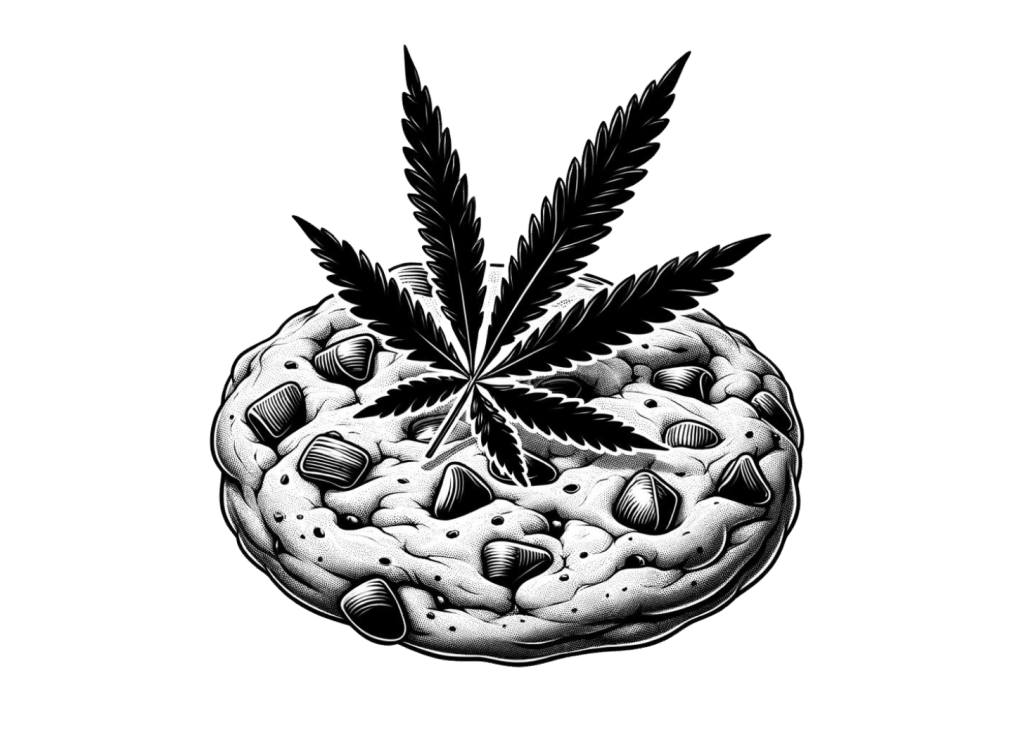
1. Cannabis-Infused Chocolate Chip Cookies
Ingredients needed:
- 2 cups flour (250 g) of all-purpose flour
- 1 teaspoon of salt
- 1 teaspoon of cornstarch
- ¼ teaspoon of baking soda
- ⅔ cup (160 g) of unsalted butter and cannabutter
- ⅔ cup (140 g) light brown sugar
- ¾ cup (60 g) of white granulated sugar
- 1 egg
- 2 egg yolks
- 2 cups (250 g) of high-quality chocolate, roughly chopped
- ⅔ cup (80 g) walnuts, finely chopped (optional)
We recommend getting a scale to measure the ingredients precisely. Baking is a science; following the recipe to a tee ensures your end product will be as delicious as possible.
Instructions:
- Melt the weed and unsalted butter together and set to the side to cool. Optionally, heat it in a saucepan until it browns slightly and develops a nutty aroma.
- Roughly chop the dark chocolate.
- Combine all-purpose flour, cornstarch, cake flour, kosher salt, and baking soda in a medium-sized bowl and whisk to combine.
- In a separate bowl, mix together the brown and white sugars, then slowly pour in the butters and beat until combined.
- Add the egg, followed by the egg yolks, and beat until fluffy.
- Fold in the flour mixture with a baker’s spatula and stir just until combined. Don’t overmix the batter.
- Add in chopped chocolate and chopped walnuts, and mix them until combined.
- Place in a bowl, cover, and refrigerate for at least 45 minutes, preferably overnight, to let the flavors and textures develop.
- Scoop out evenly-sized dough balls and place them on a parchment-lined or nonstick baking sheet.
- Bake in a 425ºF (220℃) oven for 10 to 13 minutes.
- Set the pan on a wire rack and let it cool before serving.
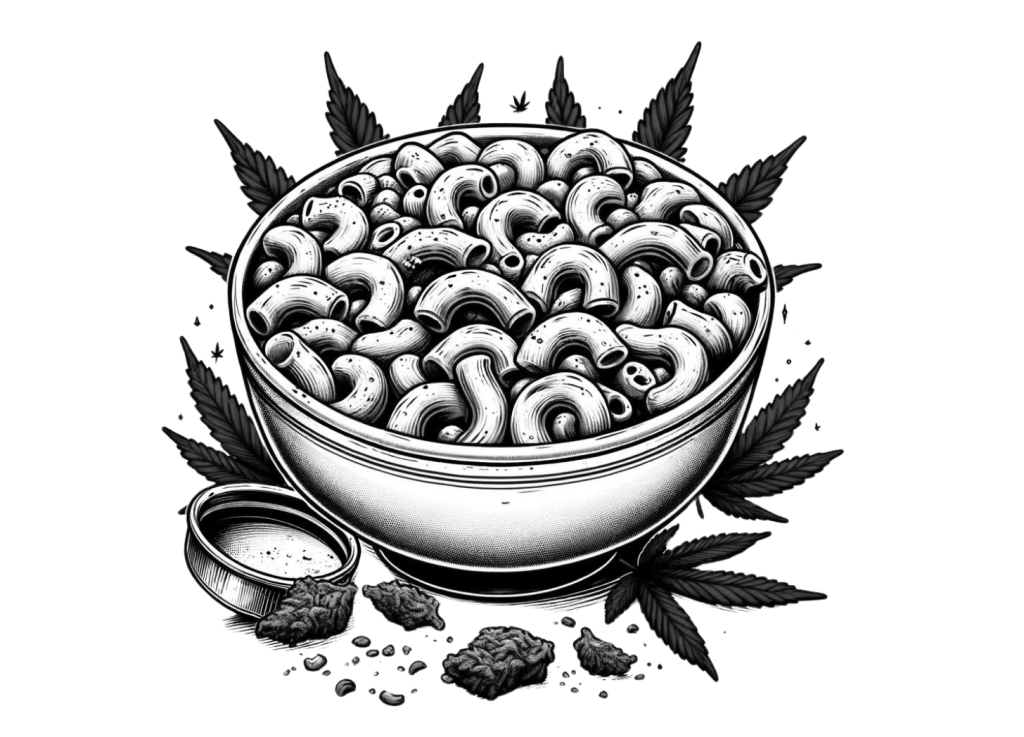
2. Cannabis-Infused Mac N’ Cheese
Ingredients needed:
- ½ pound of cooked macaroni noodles
- 5 tablespoons of butter and cannabutter
- 4 tablespoons of all-purpose flour
- 3 cups (720 g) of whole milk
- 12 ounces (340 g) of grated cheese, either gouda, provolone, cheddar, or a mix
- 1 teaspoon of smoked paprika
- 1 teaspoon of garlic powder
- Salt and pepper, to taste
- ½ cup (45 g) of breadcrumbs for garnish
Instructions:
- Preheat oven to 325ºF (163℃) and grease a medium-sized baking dish (9×13″).
- Heat a sizable pot of salted water until it reaches a boil.
- Add the dried pasta and cook for one minute less than the al dente recommendation on the package. Drain the pasta and drizzle it with olive oil to prevent sticking.
- Melt one tablespoon of weed butter in a small skillet over low heat. As soon as the butter melts, stir in breadcrumbs. Continue stirring until crumbs are evenly crisp and golden brown. Set aside and let cool.
- While water is coming up to a boil, shred the cheese. You can use one variety, such as aged cheddar, gouda, or provolone, or mix them for additional flavor. Separate a small amount to add on top.
- In a large saucepan over medium heat, melt the remaining tablespoons of butter. Gradually incorporate the flour, one tablespoon at a time, into the melted butter, whisking continuously. Cook for about 1 minute, constantly whisking.
- Slowly pour about 2 cups of cold milk while whisking and stir until smooth. Slowly pour in the remaining milk and keep whisking.
- Continue heating until the mixture thickens, constantly stirring.
- Remove from the heat and add in half the cheese, stirring to melt and combine. Stir in the rest of the cheese, mixing until completely melted and smooth.
- Mix the drained pasta with the cheese sauce in a spacious bowl and stir. Transfer the combined pasta mixture to the ready baking dish.
- Top with the cheese you set aside and the weed-infused breadcrumbs and bake for 15 minutes, until the cheese is bubbly and lightly golden brown.
Tips for Using Cannabutter & Edibles Safely
Edibles are different than other ways to use cannabis, so here are some things to be aware of when using them.
1. Cannabutter Do’s & Don’ts
The cannabinoids can settle in the butter as it cools, so slice it instead of scooping it from the top.
When adding cannabutter to a recipe, stir the sides and combine the ingredients well so it’s evenly distributed.
2. Give Edibles Plenty of Time to Take Effect
Allow up to 1 ½ hours before eating more edibles to give them a chance to really kick in fully.
Edibles produce different effects from smoked cannabis — you don’t feel it instantly [2] since the THC has to be digested before it can get into your bloodstream. This delayed onset makes it easy to grow impatient and re-dose. The effects can be too intense when they finally set in, resulting in a bad experience.
3. Use Less Since Effects & Side Effects Can be Stronger
Even if you use cannabis a lot, start with less than usual when trying edibles.
Edibles also have a higher concentration of THC and fewer cannabinoids, which provide the “entourage effect” and help balance the THC [3].
Because of this, the adverse effects of eating too many edibles can be more severe than those from smoking too much weed.
Most people who have attended the ER for cannabis intoxication report having had edibles.
4. Keep Edibles Away from Children & Pets
A large number of those ER patients are children, so label edibles properly and keep them away from kids and pets. They can look identical to their non-intoxicating counterparts, making them too tempting for those who are unaware.
If you live with children, take extra precautions to ensure your edibles don’t end up in the wrong hands.
Related: Highs & Lows — How Marijuana Affects the Brain
FAQs: Cannabutter & Weed Infusions
Looking for other information? Here are a few answers to common questions about cannabutter.

1. Can you infuse coconut oil with THC?
Yes, you can, and in fact, coconut oil is a better transporter of THC than dairy butter. Coconut oil has the highest fat content among cooking fats, which allows more THC to bind to its structure. It’s also lower in calories and cholesterol, making it a healthier alternative.
2. Does cannabutter need to be refrigerated?
Weed butter can be left out at room temperature if your house isn’t hot, provided you store it in an opaque container and in a dark spot. Be mindful of light exposure, as it could degrade its cannabinoids, lowering its quality.
3. Is my cannabutter burned?
Unless you’re making THC-infused brown butter, your weed butter should never turn dark brown or smell overly nutty. Make sure to cook it on low heat with some water, or opt for a double boiler or pressure cooker if your stove doesn’t go low enough.
References
- Wang, M., Wang, Y. H., Avula, B., Radwan, M. M., Wanas, A. S., van Antwerp, J., … & Khan, I. A. (2016). Decarboxylation study of acidic cannabinoids: a novel approach using ultra-high-performance supercritical fluid chromatography/photodiode array-mass spectrometry. Cannabis and cannabinoid research, 1(1), 262-271.
- Barrus, D. G., Capogrossi, K. L., Cates, S. C., Gourdet, C. K., Peiper, N. C., Novak, S. P., … & Wiley, J. L. (2016). Tasty THC: promises and challenges of cannabis edibles. Methods report (RTI Press), 2016.
- Ferber, S. G., Namdar, D., Hen-Shoval, D., Eger, G., Koltai, H., Shoval, G., … & Weller, A. (2020). The “entourage effect”: terpenes coupled with cannabinoids for the treatment of mood disorders and anxiety disorders. Current neuropharmacology, 18(2), 87-96.


